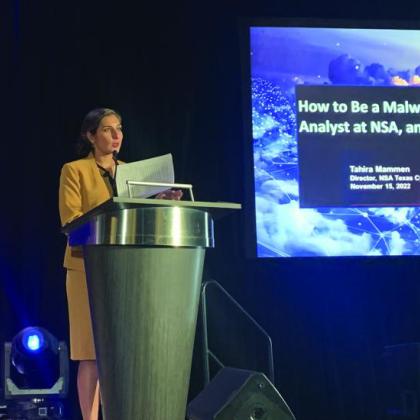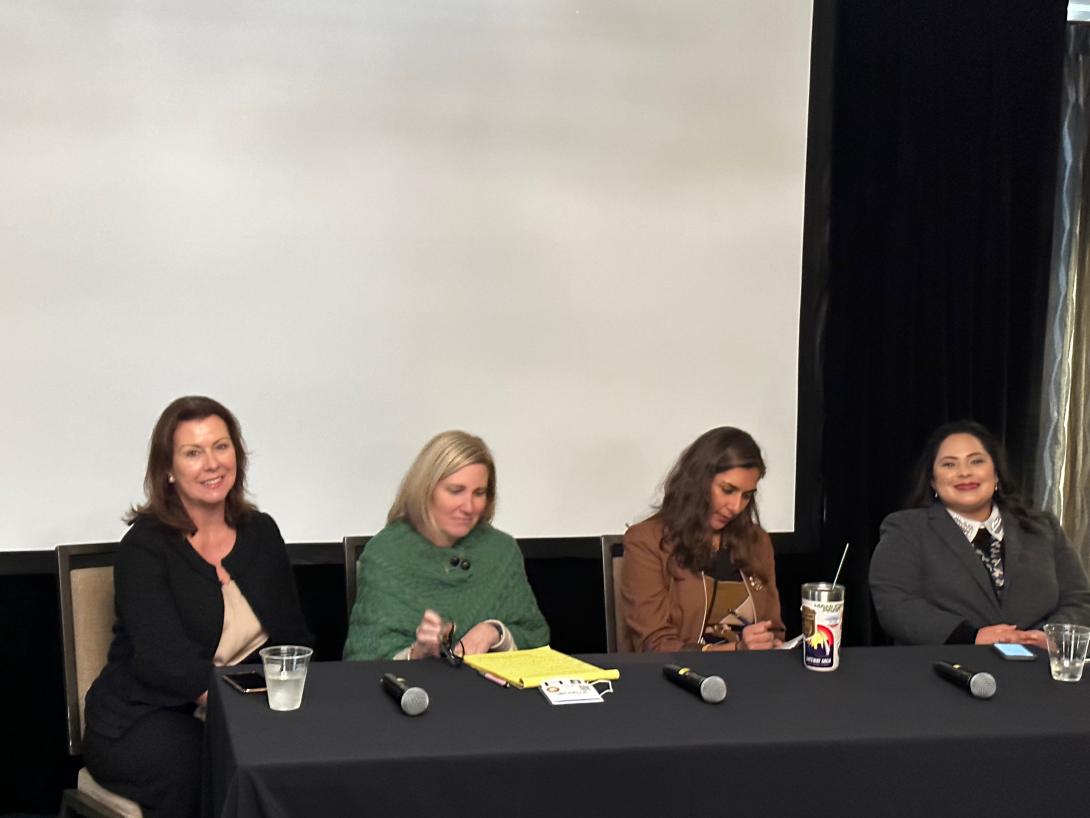Smart Leaders Learn To Leverage Multigenerational Workforce
“We live in an unprecedented time,” said Karen Rolirad, president of Women in Alamo AFCEA and chapter vice president of Diversity. “It is the first time that we have led with five generations in the workforce.”
Rolirad spoke at AFCEA Alamo’s annual ACE event held in San Antonio last week, where she moderated a panel from Women in Alamo AFCEA that was part of a series of presentations at ACE on human capital related to the Air Force and industry.
To discuss the art of leadership in a multigenerational workforce, Rolirad spoke with female leaders from across several generations including:
- Jill Singer, vice president of federal solutions at AT&T, representing the boomer generation;
- Retired Army Brig. Gen. Michelle Letcher, representing Generation X;
- Tahira Mammen, director of cybersecurity for the National Security Agency, Texas, representing an older millennial; and
- Crystal Olguin, a contractor for 16th Air Force in San Antonio, representing a younger millennial.
The five generations in the workforce today includes the silent generation or the greatest generation that experienced World War II and the Great Depression, born between 1928 and 1945. “Most of them have retired from the workforce, but some take part as partners, board members or in other advisory positions,” Rolirad explained. “That's where you're going to see the greatest generation. However, the greatest generation, they lack and struggle with technology.”
The boomer generation are folks born between 1946 and 1964 and who are in their late 50s to late 70s. “Many boomers are still in the workforce,” Rolirad noted. “Like their predecessors in the greatest generation, they value hard work, they are more self-assured, goal-oriented and disciplined.”
Generation X are those workers born approximately between 1965 and 1981 and are in their 40s to late 50s. “This generation is more direct, adaptable and independent,” Rolirad said. “This generation is often overlooked and compared to the more prominent characteristics of its neighboring generations.”
“Meanwhile, the millennials, born between 1981 and 1996 and who are in their late 20s or early 40s, are more technology savvy, crave recognition, validation and reassurance,” she explained. “And the generation is hardworking but struggles with financial uncertainty. Consequently, they have become more entrepreneurial, because they want to take finance into their own hands.”
Estimates say millennials, also known as Generation Y, will make up about 40% of the workforce in 2025, when they will be around 29-44 years of age.
For Generation Z—those born between 1997 and 2012—they are just launching their careers or joining the military.
“Gen Z is known for being the most diverse, open-minded and technology savvy generation,” Rolirad explained. “Their biggest motivators are self-improvement and making a mission impact. There is also a Gen Alpha that hasn't quite emerged yet. But Gen Alpha is on its way. So, we're starting all the way over again.”
For leaders to be effective guiding a multigenerational workforce, they need to build strong communication, a constant culture of learning, clear leadership and strategy. Most of all, a place that appreciates diverse personnel from different backgrounds, sexes, races and ages, will bring strength in decision-making, the panelists said.
“I think the strengths of a multigenerational workforce really brings us the most diverse ideas, whether we're solving a problem, or whether we're looking for a new innovation or a new opportunity,” Singer said. “By engaging all the different generations that are part of your workforce, I think you'll find there's not only perspectives by their backgrounds, but also perspective by their age differences and what they think about first, second, or third.”

My belief is, and it is backed by data, is that diverse teams make better decisions. If we build teams that are diverse, which has to include a multigenerational workforce, we're going to get better outcomes and we're also going to get more innovation.
Singer ventured that to inspire innovation, leaders today need to set in place a continuous learning environment for everyone. “When we have all five generations, and when you're next to someone who is a Gen Z, for example, they think, process and learn differently, and you pick that up as a boomer or a silent generation,” Singer added. “And it forces all of us to always be learning from each other, as we're trying to collectively go forward.”
Another strength that leaders should tap into in a multigenerational workforce is the role of mentoring, and especially reverse mentoring in their teams. “What I think is super important in a multigenerational workforce is the reverse mentoring aspect,” she said. “It is allowing people who are perhaps chronologically younger than you or younger in their careers to actually turn the tables around and talk to you from their perspective. And as a leader, you can learn a ton from them, if you can do the proverbial, ‘Be quiet and listen,’ instead of always talking.”
At NSA Texas, Mammen sees how embracing diversity in the workforce leads to stronger decision-making. “My belief is, and it is backed by data, is that diverse teams make better decisions,” she said. “I'm reading through Harvard Business Review and they had quoted that 87% of the time, a diverse team is going to make a better decision than a nondiverse team. ... If we build teams that are diverse, which has to include a multigenerational workforce, we're going to get better outcomes and we're also going to get more innovation.”
However, diversity in the workplace may need to be intentional. Leaders and hiring teams need to draw in people from all sorts of socioeconomic, ethnic, generational and other backgrounds. And then, it is a leader’s job to figure out and support how each person can do their best work that drives the mission. “You have to actually put energy into growing a diverse team, those things don't just happen,” Mammen stated. “We live off of business processes that have existed since post-World War Two for the National Security Agency. ... And when someone in a different generation is exposed to the way someone else works, the way someone else thinks and what they're bringing to the table, then you all get sparked with ideas. And those good ideas come from everywhere because everyone's allowed to be the full selves.”
Gen. Letcher added that empathy is an important trait to foster across the generational workforce. She spoke about when she was a company commander and did not have children, she may not have been aware of the struggle some of her personnel were having with childcare. “I think sharing experiences so people can exercise empathy, and respect for each other, is really important when you think about growing that, that multigenerational workforce,” she said.
Millennial leaders like to lead by example, Olguin shared. “We believe that empowerment of our followers is extremely important,” she noted.” We prefer a leader who is people-oriented versus task-oriented. For myself, I prefer a more empowering leadership style. And I believe that followers should be allowed to have independence and self-leadership, which in turn provides support, encouragement, promotes decision making and builds trust in our leaders. Displaying good listening skills from our leaders, that's kind of what we expect. We expect positive reinforcement and expect to have opportunities to provide feedback to our subordinates.”
“Leaders really need to show innovation, regardless of your generational bracket that you're in,” advised Singer. “It is a leader’s job to take on the innovation, even if it's just innovation in a business process. Innovation could be everywhere. And I think that leaders have a very important job in setting the strategic path, for the organization, for the team, for the unit, but also giving the team tactical actions to get down that path.”




Comments